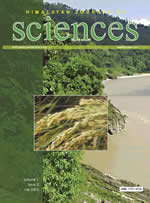Surface modification of polycarbonate (bisphenol A) by low pressure rf plasma
DOI:
https://doi.org/10.3126/hjs.v1i2.209Keywords:
Polycarbonate, surface modification, rf plasma, ageing, surface energyAbstract
Effects of low pressure radio frequency (rf) plasma treatment on the surface properties of polycarbonate are presented in this paper. Results obtained from the surface energy measurement after different conditions of treatment are compared. After treatment the surface free energy increased from the original value of 35 mJ/m2 to 63-74 mJ/m2. X-ray photoelectron spectroscopy measurements showed an increase in oxygen to carbon ratio after the treatment indicating an increase of oxygen-containing functional groups on the polycarbonate surface. A study of the stability of the modified surface property has been made on the basis of surface free energy. To study the improvement of adhesion between the polycarbonate and thin coatings, organosilicon thin films were deposited on the untreated and plasma treated polycarbonate. The adhesion of film to substrate was quantitatively analysed by ‘cross-hatch peel test’. Key words: Polycarbonate, surface modification, rf plasma, ageing, surface energy Himalayan Journal of Sciences 1(2): 115-118, 2003Downloads
Download data is not yet available.
Abstract
1162
PDF
1747
Downloads
How to Cite
Subedi, D. P., Zajickova, L., Bursikova, V., & Janca, J. (2006). Surface modification of polycarbonate (bisphenol A) by low pressure rf plasma. Himalayan Journal of Sciences, 1(2), 115–118. https://doi.org/10.3126/hjs.v1i2.209
Issue
Section
Research Papers




